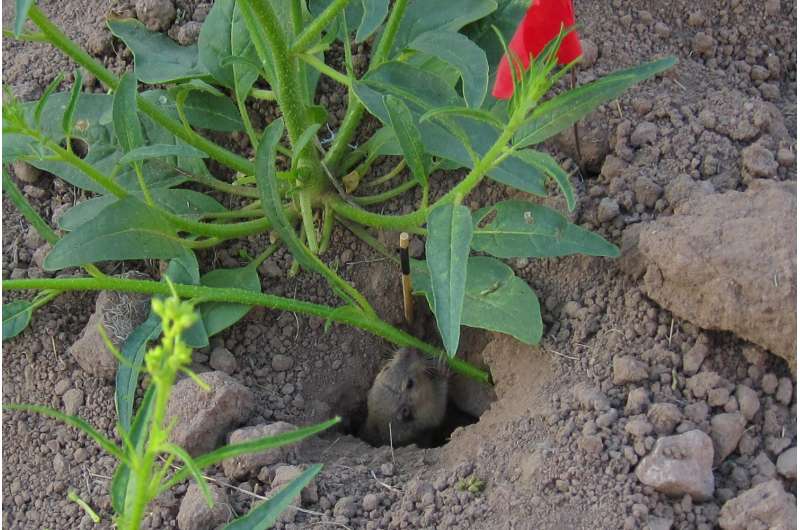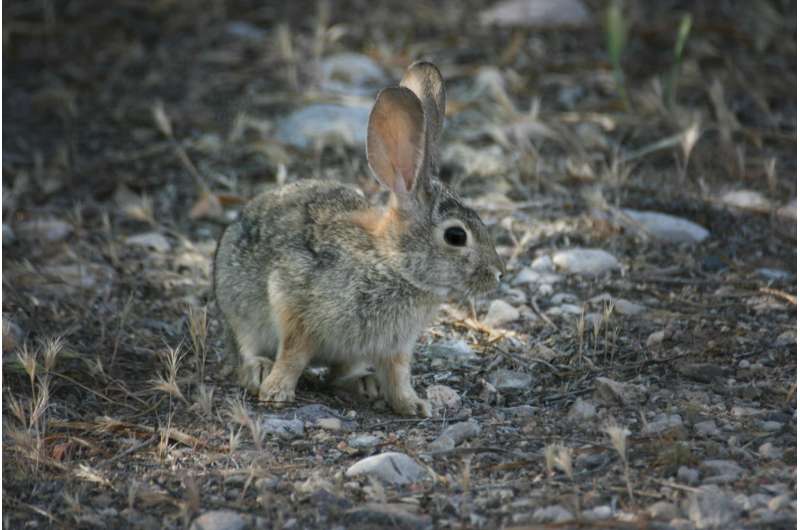Jasmonate-deficient tobacco plants attract herbivorous mammals

Coyote tobacco (Nicotiana attenuata) produces a potent neurotoxic substance: nicotine. The production of nicotine is regulated by plant hormones called jasmonates. Scientists at the Max Planck Institute for Chemical Ecology in Jena, Germany, the University of Bern, Switzerland, and Washington State University have now demonstrated the importance of jasmonate-dependent nicotine production for the survival of tobacco plants which are attacked by mammalian herbivores. Through experiments with genetically modified plants that are impaired in their ability to produce jasmonates, the researchers showed that jasmonate-deficiency strongly increases attacks by both insects and vertebrates. Interestingly, insect attack did not significantly affect flower production and attacked plants were still able to produce seeds, whereas attack by herbivorous mammals had a strong negative impact on the plants' reproductive ability. The scientists found that nicotine plays a crucial role in this context. Especially rabbits liked to peel the stems of nicotine-deficient plants, which strongly reduced flower production. However, when nicotine accumulates in the outer layers of the stem epidermis, it provides extremely effective protection against this type of damage. The study published in the journal eLife illustrates the importance of jasmonate-dependent defenses to provide protection against mammalian herbivores in nature.
The coyote tobacco Nicotiana attenuata grows in the southwestern United States. For nearly 20 years, this wild plant species has been studied by scientists in the Department of Molecular Ecology, headed by Ian Baldwin, at the Max Planck Institute for Chemical Ecology. Many herbivorous animals are interested in the tender green plants which emerge after the vegetation has been burned by fires caused by lightning. However, these plants are surprisingly well protected against their enemies. The plant metabolite nicotine, a potent neurotoxin, ruins the appetite of many hungry herbivores. To find out more about the defensive mechanisms of these plants and their effects on interactions with other organisms in their environment, the scientists perform field experiments with genetically modified plants in which single genes which regulate plant defenses have been silenced. Field trials are conducted in one of the natural habitats of the coyote tobacco, the Lytle Ranch Preserve in southwestern Utah, USA.
During the 2012 field season, the researchers observed that many Nicotiana attenuata plants were heavily defoliated by small mammals. These animals, which include gophers and rabbits, are usually very reclusive and are rarely seen in the field plots. When the scientists analyzed the damaged plants, they found that most of the plants that had been attacked by mammalian herbivores were impaired in their ability to produce jasmonates (inverted-repeat allene-oxide cyclase, irAOC plants). Jasmonates are phytohormones which are well known to regulate several physiological processes in plants, including defenses against insect herbivores. By contrast, little was known about their role in protecting plants against vertebrates. The scientists therefore decided to investigate this phenomenon in more detail.

Attack by mammals has a more severe impact on plants than attack by insects
A more detailed analysis of the damage patterns showed that the damage by both insects and mammals to these plants was greater than the damage to wild-type plants. This result was not surprising because a metabolic screening had revealed that irAOC plants produced significantly fewer defensive substances than did the controls; this was especially true for levels of nicotine in the leaves and the stems. However, only damage caused by mammals had a negative impact on flower production. Unlike insects, mammals prefer to peel the stems of plants; as a consequence, flower production and therefore seed production, is impaired. The number of seeds are a measure of a plant's reproductive ability and thus its fitness, and without flowers, this ability is lost. In addition, the stem of a plant is an important transport and storage organ for water and nutrients. The nicotine in the outer epidermal layers of the stem is therefore of special importance to protect this vital organ from herbivore attack.
The chemistry of tobacco plants influences feeding preferences in small mammals

Since mammalian herbivores, such as rabbits, preferred to feed on jasmonate-deficient plants and these plants produce less nicotine, apart from many other defenses, the scientists wanted to know whether nicotine content in the stems and leaves could actually explain the damage caused by mammals. Matthias Erb, who previously led a research group at the Max Planck Institute in Jena and is now a professor at the University of Bern, and Ricardo Machado, who got his PhD in Jena and is now a postdoctoral researcher in Bern, teamed up with Mark McClure from Washington State University to develop a feeding assay for mountain cottontail rabbits (Sylvilagus nuttallii), a species of small rabbits that naturally feed on Nicotiana attenuata plants. The scientists made food pellets from both dried wild-type and dried jasmonate-deficient tobacco plants and presented these pellets to the rabbits along with pellets from alfalfa, their favorite food plant. During 24 hours, the rabbits rapidly consumed jasmonate-deficient and alfalfa pellets. In contrast, the amount of consumed wild-type pellets was nearly zero. The hypothesis that nicotine determines the rabbits' feeding preferences was confirmed in a further experiment which showed that jasmonate-deficient pellets were refused by the rabbits when nicotine was added. The scientists were surprised that rabbits were interested in tobacco pellets as much as in alfalfa. "We expected rabbits to eat all control pellets first, but instead they alternated consumption of these pellets with those containing jasmonate-deficient tobacco plants. This suggests that rabbits wanted something in Nicotiana attenuata, but needed to dilute the toxins in these plants in order to obtain it," explains Mark McClure.
A renewed interest in the role of mammals in plant defense syndromes
Mammals have long been known to have a strong impact on plant survival and community composition. However, most previous studies on the ecology and evolution of plant defenses, including studies on the role of jasmonates and nicotine in Nicotiana attenuata, focused on insect herbivores. Field experiments with genetically modified plants that were impaired in their ability to produce jasmonates now revealed that plant defense mechanisms may also have evolved as a result of interactions with herbivorous mammals. "We were absolutely amazed how great the negative impact of mammalian herbivory on plant fitness is when plants are jasmonate-deficient" says first author Ricardo Machado. Tobacco plants without jasmonates produce very few flowers when they are attacked by mammals.
"If we want to understand how plant defense mechanisms evolved and how plants survive in nature, we need to study the impact of entire herbivore communities, including both insects and vertebrates," Erb, the leader of the study, summarizes. The researchers want to perform more experiments using mammals as potential herbivores of tobacco plants. In a future project, the scientists aim at investigating whether small mammals, such as the wood rat, uses nicotine-containing tobacco leaves in their nests as a protection against parasites. [AO]
More information: eLife, June 2016, DOI: 10.7554/eLife.13720
Journal information: eLife
Provided by Max Planck Society


















